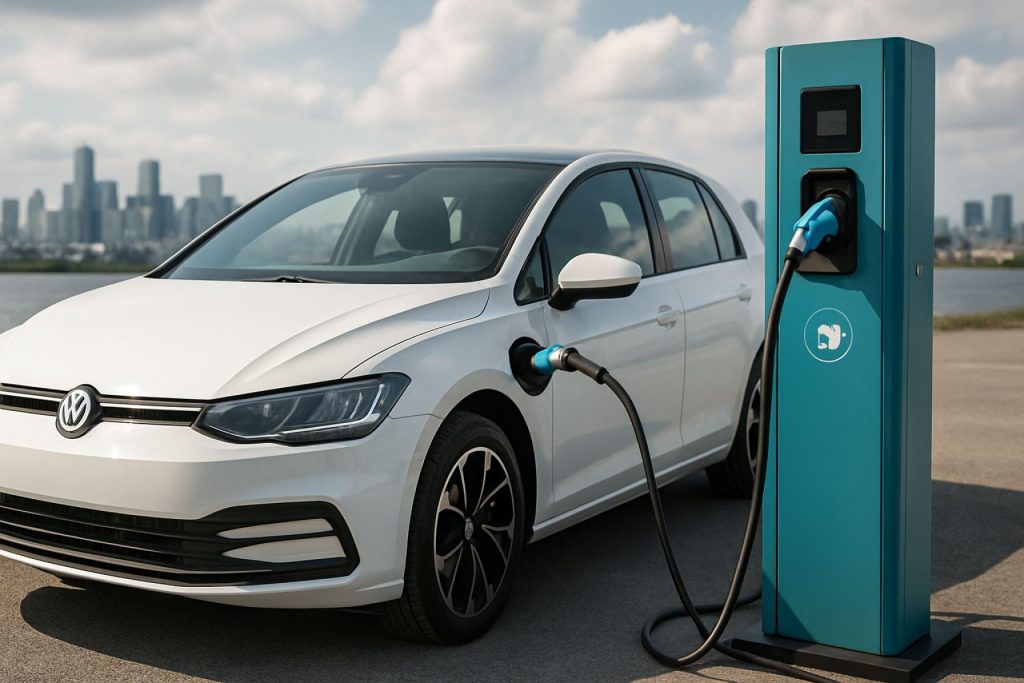
- Electric vehicles (EVs) are rapidly becoming mainstream, with projections showing one in four cars sold globally will be electric by next year.
- Worldwide EV sales are surging, especially in China—where almost half of new cars are electric—and significant growth is seen in Asia, Latin America, Europe, and the US.
- Declining battery costs and supportive government policies are making EVs affordable and accessible to everyday drivers.
- EV ownership brings lower maintenance costs, abundant charging stations in cities, and reduced emissions, contributing to cleaner air and healthier urban environments.
- The global shift to EVs signals a move away from oil dependency, ushering in new economic and environmental opportunities for the future.
A quiet but profound transformation is racing across the world’s roads: electric vehicles (EVs) are swiftly moving from novelty to norm. Showrooms from Shanghai to São Paulo are reporting surges, and the numbers electrify—the latest data reveals that by next year, at least one out of every four cars sold globally will be an EV, according to credible energy analysis.
Pavements that once echoed the growl of engines now hum with the silent rush of innovation. In 2025 alone, drivers are expected to purchase more than 20 million electric cars worldwide, eclipsing previous years and marking a seismic shift for the international auto industry. The early months of 2025 have already witnessed a remarkable 35% leap in EV sales over the same period the previous year, a signal that the appetite for plug-in transport is not just growing, but surging.
In China, the world’s EV pacesetter, the revolution borders on breathtaking. Nearly half of all vehicles newly rolling off the lot are electric—as familiar as a smartphone in urban lots from Beijing to Shenzhen. This dominance is mirrored in the expanding appetite for EVs in Asia and Latin America, where sales soared more than 60% in recent reports. Across the United States and Europe, consumers are joining this movement: American EV sales rose nearly 10%, while Europe saw a healthy jump of 20%.
As battery costs plummet and governments push for cleaner air, EVs are escaping their luxury niche and entering mass-market territory. This democratization means EVs aren’t just for the early adopters—they’re increasingly affordable for families and commuters across continents. Analysts now project that EVs could command over 40% of the new car market within five years—a statistic that would have seemed unlikely only a few years ago.
The reasons go far beyond the novelty of driving electric. EV owners enjoy tangible savings: charging stations increasingly outnumber gas pumps in urban hubs, maintenance costs are often slashed in half, and skipping the gas station quickly becomes second nature. For cities battling smog and climate change, the benefits compound—every EV replacing a combustion engine car slashes tailpipe emissions and helps cool urban heat, offering a local answer to a planetary crisis.
But there’s a broader story unfolding. As EVs chart their course toward mass adoption, they symbolize a shift in global power: oil’s long dominance over mobility is facing a challenger that promises cleaner air, healthier cities, and new economic opportunities.
In the coming months, energy agencies and experts plan to share deeper analysis of EV supply chains, auto industry innovation, and the unexpected geopolitical implications of this shift. The world is not yet fully electric, but as battery production scales and carmakers compete, driving electric is rapidly becoming less of a statement and more of the default choice.
The road ahead is charged with promise. If you’re considering a new car—or simply breathing the air on your morning walk—the rise of electric vehicles is a story that affects us all.
Looking for more news and fresh perspectives? Dive into the latest in world energy, tech, and sustainability at The New York Times or keep up to date with in-depth global reports from the experts at The International Energy Agency.
Takeaway: The electric car surge isn’t just a trend—it’s a transportation revolution. The shift promises cleaner air, quieter streets, and the chance to step away from fossil fuel dependency. The question is not whether the world will go electric, but how quickly—and how this transformation will reshape daily life for people everywhere.
Electric Cars Charge Ahead: Surprising Facts, Smart Tips & Predictions On the EV Revolution
Unpacking the Global Electric Vehicle (EV) Boom: What You Need to Know
The global electric vehicle surge is transforming not just roads, but economies, cities, and climate strategies. This movement is bigger than buzz—it’s fundamentally reinventing how we drive, fuel, and interact with technology. Here’s an in-depth look at crucial EV facts, market trends, expert insights, controversial challenges, and actionable tips you won’t want to miss.
—
Further Facts: What the Source Didn’t Fully Explore
1. Battery Tech Advances: Faster, Safer, Cheaper
– Solid-State Batteries: A game changer, solid-state batteries deliver improved safety, greater energy density (meaning longer range), and much faster charging. Toyota and Samsung are racing toward commercialization by 2027 ([source](https://www.iea.org)).
– Recycling Innovations: Companies like Redwood Materials and Tesla are closing the loop by recycling old batteries to recover lithium, nickel, and cobalt—addressing sustainability concerns.
– Battery Prices: Lithium-ion battery pack prices have dropped over 80% since 2010, helping drive the affordability wave (source: Bloomberg NEF).
2. EV Infrastructure: Beyond Urban Hubs
– Ultra-Fast Charging Networks: Providers such as Electrify America and IONITY offer 350 kW chargers, enabling up to 200 miles of charge in just 20 minutes.
– Rural Rollout: Countries like Norway and the Netherlands now ensure charging stations are accessible every 50 km on main roads, easing range anxiety for commuters in remote areas ([source](https://www.iea.org)).
– Home Charging: Over 80% of EV owners charge at home, and new smart chargers adjust rates to sync with off-peak renewable energy supply.
3. Market Insights & Regional Trends
– Asia’s Leadership: China manufactures over 60% of all EVs globally and dominates the battery supply chain.
– Europe’s Incentives: Many European cities offer tax breaks, free parking, and access to low-emission zones.
– U.S. Federal Push: The 2023 Inflation Reduction Act in the U.S. included major tax credits for American-made EVs and batteries (up to $7,500 per vehicle).
4. Real-World Use Cases
– Ride-Sharing: Companies like Uber and Lyft pledge to go 100% electric by 2030 in major markets.
– Commercial Fleets: Amazon, FedEx, and DHL are rapidly electrifying delivery vehicles, cutting urban emissions and operational costs.
5. Limitations, Controversies & Challenges
– Mining & Human Rights: Lithium and cobalt mining has been linked to environmental harm and labor abuses—groups advocate for stronger ethical sourcing.
– Grid Readiness: Increased electricity demand could strain local grids; smart grid technology and distributed solar are key mitigations.
– Resale Value: While improving, some EVs depreciate faster than gas cars, though models from Tesla and Hyundai buck this trend.
6. Features, Specs & Pricing
– Range: 2024 EVs typically offer 250–400 miles per charge. Luxury models like the Lucid Air boast over 500 miles.
– Pricing: The average EV price is approaching parity with gas vehicles in many markets, especially after incentives.
– Safety: Electric vehicles consistently rank high in crash tests, with lower rollover risk thanks to battery placement.
7. Security & Sustainability
– Cybersecurity Risks: Like all connected cars, EVs are vulnerable to software hacks. Industry standards such as ISO/SAE 21434 are being adopted for better protection.
– Green Credentials: Lifetime emissions for EVs are 3–5x lower than gas vehicles even accounting for battery production ([source](https://www.iea.org)).
—
Life Hacks & How-To Steps
Get the Most from Your EV:
1. Plan Routes with Chargers: Use apps like PlugShare or A Better Routeplanner.
2. Use Off-Peak Charging: Save money and reduce grid strain—schedule home charging late at night.
3. Check Incentives: Visit local government websites for rebates, free parking, or carpool lane access.
4. Battery Maintenance: Keep charge levels between 20–80% for optimal battery health.
5. Stay Updated: Subscribe to trusted outlets like The New York Times and IEA for the latest news and guides.
—
Most Pressing Questions & Expert Answers
Q: Are EVs really better for the planet?
> Yes, according to the International Energy Agency, EVs produce significantly less lifetime CO₂ and toxic emissions—even factoring in battery manufacturing and electricity mix.
Q: Do EV batteries wear out quickly?
> Modern batteries retain up to 80% capacity after 8–10 years; most manufacturers offer 8-year/100,000-mile battery warranties.
Q: How does winter/cold affect range?
> Range can drop by 15–30% in cold weather, but pre-conditioning (warming your EV while plugged in) and cabin heat pumps help minimize this.
Q: Are there enough charging stations for long trips?
> In the U.S. and Europe, public fast-charging infrastructure is expanding rapidly, minimizing range anxiety for most routes.
—
Pros & Cons Overview
Pros:
– Lower operating and maintenance costs
– Instant torque and quiet ride
– No tailpipe emissions
– Eligible for tax credits and incentives
Cons:
– Upfront cost can be higher (offset by incentives)
– Charging infrastructure still growing in some areas
– Battery replacement is costly (although occurrence is rare)
—
Actionable Recommendations & Quick Tips
– Test-drive an EV: Many dealerships and manufacturers offer extended demos.
– Compare total cost of ownership: Factor in fuel, insurance, and maintenance when evaluating affordability.
– Look for certified pre-owned EVs: Significant savings with warranty protection.
– Check eligibility for workplace or apartment charging grant programs.
– Keep an eye on battery tech: Upcoming solid-state batteries could offer even better value in the next 2–3 years.
—
Future Insights & Industry Predictions
– By 2030, EVs could account for almost 60% of global car sales if current trends and policies persist.
– Demand for green jobs: Battery recycling, software development, and charger installation are rapidly growing sectors.
– Emergence of V2G (Vehicle-to-Grid): EVs will increasingly help balance utility grids and store renewable energy at scale.
—
Conclusion
The move to electric cars is a defining shift for 21st-century mobility—promising a cleaner planet, quieter streets, and new economic opportunities. If you’re thinking about your next car, or just want to breathe easier in your city, there’s never been a better time to fuel your curiosity—and maybe your garage—with electric.
—
Looking to learn more or keep up with this evolving industry? Check resources from IEA for impartial energy analysis and The New York Times for informed reporting on world trends and technology breakthroughs.



